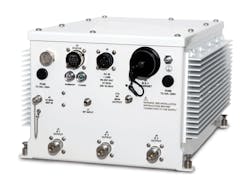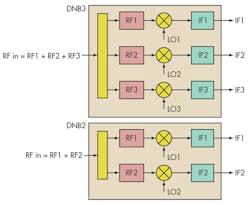Related Articles
• Tube Amplifier Powers Ku-Band Systems
• Ku-Band Carries Asian Services
• OMTs Operate Over K- and Ka-Bands
Satellites are transferring a growing amount of information, with suppliers of satellite communications (satcom) hardware being asked to deliver higher-performance, innovative subsystem solutions. MITEQ’s response has been the development of outdoor Ku- and Ka-band block frequency downconverters and upconverters capable of handling multiple wide bandwidths within a single converter unit. These rugged, antenna-mounted assemblies can work with two or three intermediate-frequency (IF) signals across bandwidths as wide as 0.95 to 2.45 GHz and upconvert them to one composite broadband RF output either in Ku or Ka band. Conversely, with the downconverter, a composite Ku-band signal from 10.70 to 12.75 GHz or Ka-band signal from 27.0 to 31.0 GHz or 17.7 to 22.0 GHz is downconverted into two or three independent IF signals. The new MITEQ multicarrier converters are available in a variety of configurations to help system architects achieve reliable, high-performance levels in satcom hub terminal applications.
This file type includes high resolution graphics and schematics when applicable.
These compact wideband Ku- and Ka-band frequency downconverters and upconverters from MITEQ (Fig. 1) can reduce satcom equipment installation time at an antenna. They also save money, both in terms of equipment (using one frequency converter in place of two or three) and operating costs, with the power consumption for one of these frequency converters being considerably less than for two or three separate frequency converters. The new frequency converter units achieve their compact dimensions by packing the equivalent of two or three sets of frequency-conversion components (Fig. 2)—including RF amplifiers, IF amplifiers, frequency mixers, and local oscillators (LOs), along with a full set of monitoring and control circuits and functionality—into a compact, weatherproof housing.
2. This simplified block diagram of a wideband frequency downconverter shows the creation of multiple IF outputs from a single RF input port.
The wideband frequency converters offer impressive performance and functionality. They are designed to work with a stable external 5- or 10-MHz reference oscillator, but each frequency converter also contains an internal reference oscillator and each converter includes circuitry to detect the presence of the more appropriate frequency reference source for optimum performance. For example, if the power level of the external reference drops below +1 dBm, the converter will automatically lock to the internal frequency reference. Each frequency converter includes 10/100Base-T Ethernet and RS-485/RS-422 digital interfaces for remote control purposes, and each incorporates a gain-control adjustment with 30-dB range for setting RF-to-IF levels in the downconverters and IF-to-RF levels in the upconverters.
The frequency converters boast phase-noise performance that exceeds the requirements of IESS308/309 and MIL-STD-188-164B specifications. Each outdoor unit is equipped with an AC power supply with power factor correction, and each is designed for a 100 to 240 VAC power supply and low power consumption. Said power consumption is typically 50 W when working with frequencies below 15 GHz and typically 60 W when working with frequencies above 15 GHz. The converters are RoHS-5 compliant, meaning that they may contain lead, but no other RoHS-restricted materials.
A Tale Of The Numbers
Taking a closer look at the frequency downconverters, each is specified for input and output return loss (at 50 Ω) of 18 dB. The downconverters provide two or three IF outputs at +18 dBm or more output levels, with 30-dB gain, flat within ±3 dB. Gain can be adjusted independently for each IF output, in increments of 0.2 dB, over a gain-control range of 30 dB. At constant temperature, the gain is stable within ±0.25 dB/day and within ±2 dB over a 1-GHz bandwidth and temperature range of -40 to +50ºC. The frequency downconverters exhibit worst-case amplitude response of ±0.5 dB per 40 MHz of bandwidth and ±1 dB per 1 GHz of bandwidth. The rugged little downconverters achieve in-band spurious performance of -65 dBc with 80-dB minimum image rejection and worst-case noise figure of 15 dB at the minimum attenuation level.
The phase-noise levels are tightly controlled for all of the compact Ku- and Ka-band frequency downconverters, whether the units provide two or three IF outputs. As an example, model DNB2-W-20.45 is a wideband frequency downconverter with two IF outputs at 1.5 to 2.0 GHz and 1.0 to 2.0 GHz. They represent the translated RF signals from bands of 19.7 to 20.2 GHz and 20.2 to 21.2 GHz (from a single RF input port), via LOs of 18.2 and 19.2 GHz.
Model DNB3-W-29.5-1.5 is a wideband frequency downconverter with three IF output ports, all from 0.95 to 2.45 GHz. They are the downconverted frequencies from RF bands of 27.0 to 28.5 GHz, 28.3 to 29.8 GHz, and 29.5 to 31.0 GHz, again by way of a single RF input port, and translated by means of LOs at 26.05, 27.35, and 28.55 GHz. For both wideband frequency downconverters, the phase noise is low. At Ku-band frequencies (about 12 to 18 GHz), the phase noise is -48 dBc/Hz offset 10 Hz from the carrier, -73 dBc/Hz offset 100 Hz from the carrier, -103 dBc/Hz offset 1 kHz, -112 dBc/Hz offset 10 kHz, and -132 dBc/Hz offset 1 MHz.
At Ka-band frequencies (about 26.5 to 40.0 GHz), the phase noise is -41 dBc/Hz offset 10 Hz from the carrier, -64 dBc/Hz offset 100 Hz, -94 dBc/Hz offset 1 kHz, -102 dBc/Hz offset 10 kHz, and -124 dBc/Hz offset 1 MHz. These frequency downconverters are also specified for phase noise at K-band frequencies (about 18 to 27 GHz), with performance levels of -42 dBc/Hz offset 10 Hz, -67 dBc/Hz offset 100 Hz, -97 dBc/Hz offset 1 kHz, -106 dBc/Hz offset 10 kHz, and -126 dBc/Hz offset 1 MHz from the carrier.
Housed in similarly compact enclosures, the wideband frequency upconverters provide performance levels that are likewise outstanding. They also feature 18-dB input and output return loss, slightly less gain at 27 dB, but similar 30-dB gain-control range, adjustable in 0.2-dB steps. The gain stability is similar to that for the downconverters, with similar image-rejection and spurious performance levels. As with the frequency downconverters, the maximum peak-to-peak group delay per channel is 1 ns, and worst-case noise figure is 15 dB at the minimum attenuation level.
The frequency upconverters also offer excellent phase-noise characteristics. To provide examples, model UPB2-W-13.625 is an upconverter which works with separate IF input ports at 0.95 to 1.45 GHz and 0.95 to 1.70 GHz, which are translated by means of LOs at 11.8 and 12.8 GHz to RF bands of 12.75 to 13.25 GHz and 13.75 to 14.50 GHz, available at a single RF output port. Model UPB3-W-29 is a frequency upconverter with three IF input ports, all operating at 0.95 to 1.75 GHz, translated with the assistance of LOs at 27.05, 27.75, and 28.45 GHz, to three RF output bands at 28.0 to 28.8 GHz, 28.7 to 29.5 GHz, and 29.4 to 30.0 GHz, available at a single RF coaxial output port.
Related Articles
• Tube Amplifier Powers Ku-Band Systems
• Ku-Band Carries Asian Services
• OMTs Operate Over K- and Ka-Bands
The phase-noise performance is similar to that for the frequency downconverters. At Ku-band frequencies, the phase noise is -48 dBc/Hz offset 10 Hz from the carrier, -73 dBc/Hz offset 100 Hz, -103 dBc/Hz offset 1 kHz, -112 dBc/Hz offset 10 kHz, and -132 dBc/Hz offset 1 MHz from the carrier. At Ka-band frequencies, the phase noise is -42 dBc/Hz offset 10 Hz, -67 dBc/Hz offset 100 Hz, -97 dBc/Hz offset 1 kHz, -106 dBc/Hz offset 10 kHz, and -126 dBc/Hz offset 1 MHz from the carrier.
Such outstanding satcom frequency-converter performance comes from enclosures that measure just 13.0 x 9.90 x 7.25 in. (330.2 x 251.5 x 184.0 mm) and weigh nominally 17 lbs (7.71 kg) or no more than 20 lbs (9.07 kg) with options. The frequency converters use SMA female connectors below 17 GHz, 3.5-mm connectors below 17 to 22 GHz, 2.9-mm connectors above 26.5 GHz, and N female connectors at L-band frequencies. These rugged outdoor units are designed for operating temperatures from -40 to +50°C and altitudes to 10,000 ft. Between their small physical size and ability to pack two or three frequency bands into a single box, they represent a major step toward the simplification of satcom infrastructure.
This file type includes high resolution graphics and schematics when applicable.
MITEQ, Inc., 100 Davids Dr., Hauppauge, NY 11788; (631) 436-7400, FAX: (631) 436-7430.
About the Author
Jack Browne
Technical Contributor
Jack Browne, Technical Contributor, has worked in technical publishing for over 30 years. He managed the content and production of three technical journals while at the American Institute of Physics, including Medical Physics and the Journal of Vacuum Science & Technology. He has been a Publisher and Editor for Penton Media, started the firm’s Wireless Symposium & Exhibition trade show in 1993, and currently serves as Technical Contributor for that company's Microwaves & RF magazine. Browne, who holds a BS in Mathematics from City College of New York and BA degrees in English and Philosophy from Fordham University, is a member of the IEEE.



